Despite the problems with his arguments about authorship, Provan ‘s commentary on Ecclesiastes (NIV Application)
is quite good. He rightly translates HEBEL as “vapor” or “breath” rather than as “vanity,” and does a good job of showing how deeply that change transforms our reading of the book. The following are some reflections stimulated by Provan’s commentary, and, again, by James Jordan ‘s BH lectures.
1) One might characterize modernism as the systematic effort to expunge the reality of the vaporousness (fleetingness, elusiveness) of human thought and life. Modernism is one massive experiment in shepherding wind; think of the political/economic vanities of communism. That experiment collapsed from within the modern world, especially from within modern science; quantum mechanics is the revenge of the vapor. So is modern astronomy; by demonstrating the vastness of space, it shows that humanity is indeed but a drop in the bucket.
2) At the same time, modernism is a vaporizing force, especially sociologically. When the modern West met traditional culture, “all that’s solid melts into air,” as Marx said. In this sense, postmodernity (as a socio-economic reality) is an intensified form of modernity.
3) Postmodernism (as a philosophical, artistic, cultural movement) embraces the vapor, celebrates vapor, thematizes vapor. It rejects the totalizing schemes of modernism, the modern effort to shepherd the wind. What is Derrida’s theory of language but the recognition that our words are merest breath, that escapes authorial control as soon as it is out of our mouths (or off our pens)?
4) What postmodernism fails to grasp is the permanence that Solomon says is the backdrop to the vapor of human existence – the round of sunrise and sunset, the unfilled sea, the generations rising and falling. This permanence is precisely what manifests the vaporousness of human existence, which leaves barely a scratch on the adamantine surface of the universe. Pickstock has suggested that the postmodern view that the world is Dionysian flux all the way down, then there is no real change, no transition, no movement, no life. Absolute flux is another form of absolute stasis.
5) Solomon is thus neither Heraclitean nor Parmenidean, neither Apollonian nor Dionysian, yet admits the reality of both poles. He is instead . . . what? Baroque? A Christian humanist?
6) Provan points out that for Solomon, the human pursuit, the pursuit that is frustrated by the vaporousness of life, is a pursuit for YITRON, gain (Ecclesiastes 1:3). Provan suggests that YITRON essentially means “surplus,” “something left over.” When the balance sheet of a life is tallied up, we want to be in the black. Provan suggests that Ecclesiastes 1, without directly answering the question of whether gain is possible in human life, implies that it is not by pointing to the “gainless” round of created cycles. Sunrise today showed no progress over sunrise yesterday; the ocean doesn’t show a profit as the rivers flow into it. Why then should we expect human life, which is fleeting, to show gain?
7) Solomon’s reflections on vapor are reflections on life “under the sun,” which Jordan has interpreted not as a geographic/spatial designation, but as a temporal one. “Under the sun” means “pre-eschatologically,” the time before the time when there will be no more sun, the time before the rending of the firmanent-veil. Thus, within the sub-eschatological world, there is no gain, all passes, all is vapor.
8) This eschatological qualification fits with the NT uses of the Ecclesiastes language of vaporousness. The creation was “subjected to futility” until the revelation of the sons of God. Does this mean then that eschatologically, there will be gain, that losses will be recovered? Is this the meaning of the resurrection of the body? Will the lost artefacts of a godly life be raised with the body? Will all our vapor be gathered up and “solidified” along with the gift of a Spiritual body? (Ain’t it cool how eschatology came up under point #8?)
9) If we can say this (and even if we can’t push it), then we come round (again) to the conclusion that one of the key features of postmodernism is its rejection of eschatological closure, its belief that dissemination and differance continue unto the ages of ages without final judgment, with no final word. It also means that our efforts to achieve “gain,” something “left over” from our efforts, something in the positive side of the ledger, are all done in faith and not by sight; for that we are in the black is manifest only at the final judgment. What does it profit a man . . . ? And yet there is profit, treasures stored up, but not visibly here under the sun but in the heavenly kingdom when the sun is no more, treasures that we know we have only because a reliable source has told us of their existence.
10) And, golly, I’m back to the New Perspective on Paul.















